Top speed 454 km/h Retired 1961 | Introduced November 1940 First flight September 24, 1939 | |
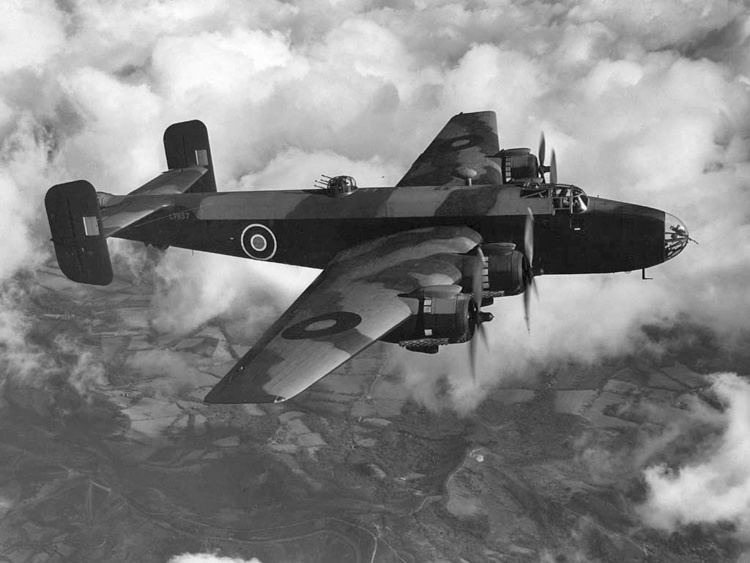 | ||
Manufacturers | ||
Handley page halifax heavy bomber mark vii na 337
The Handley Page Halifax was a four-engined heavy bomber operated by the British Royal Air Force during World War II. The Halifax remained in service until the end of the war, performing a variety of duties in addition to bombing. It was a contemporary of the Avro Lancaster. The Halifax was also operated by the Royal Canadian Air Force, Royal Australian Air Force, Free French Air Force and Polish forces. After World War II it was flown by the Royal Egyptian Air Force, the French Armée de l'Air and the Royal Pakistan Air Force.
Contents
- Handley page halifax heavy bomber mark vii na 337
- Handley page halifax in colour
- Design and development
- Accommodation and armament
- Production
- Operational service
- Civilian operation
- Pre Halifax designs
- HP57
- HP58
- HP59
- HP61
- HP63
- HP70
- HP71
- HP70 Halton
- Halifax military operators
- Halifax civil operators
- Halton operators
- Survivors
- Specifications Mk III
- References
Handley page halifax in colour
Design and development
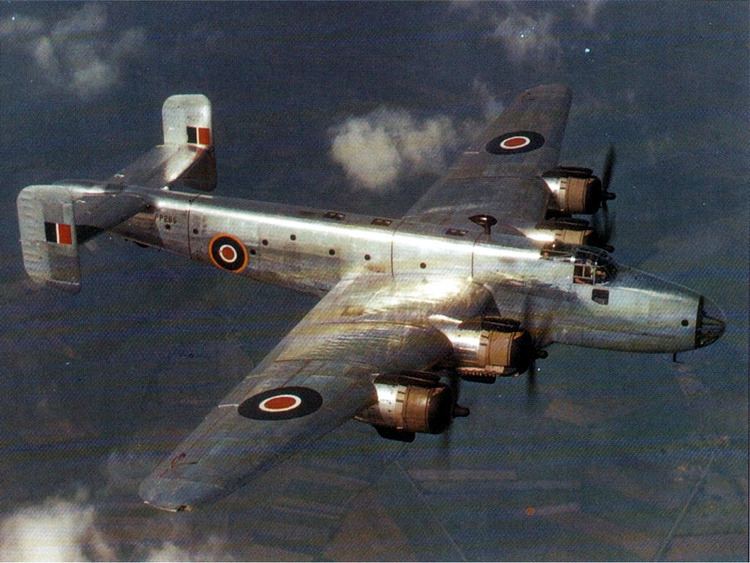
Handley Page produced the HP56 design to meet Air Ministry Specification P.13/36 for a twin-engine medium bomber for "world-wide use". Other candidates for the specification included the Avro 679, and designs from Fairey, Boulton Paul and Shorts; all were designed around a two-engine installation, using the Rolls-Royce Vulture, Napier Sabre, Fairey P.24 or Bristol Hercules. Most of these engines were under development. While four-engined bombers were considered for specification B.12/36 for a heavy bomber, wings mounting two engines were still in the experimental stage requiring testing at the RAE and the resulting increase in overall weight of stronger wing meant further strengthening of the whole aircraft structure. George Volkert at Handley-Page had responsibility for the design.
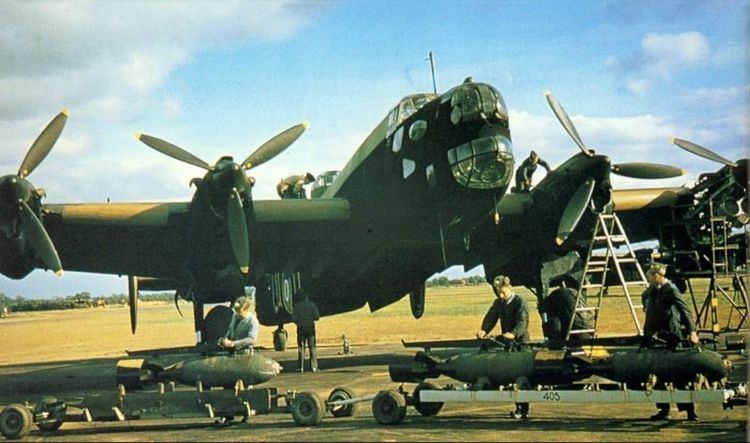
Following consideration of the designs by the Air Ministry in February 1937, the Avro design was selected with the Handley Page as "second string" and two prototypes of each were ordered.
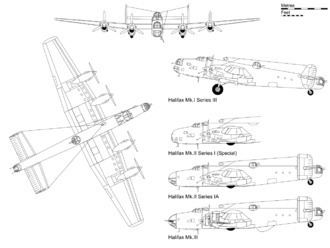
The introduction of the successful P.13/36 candidates was delayed by the necessity of ordering more Armstrong-Whitworth Whitley and Vickers Wellington bombers first. For quicker delivery Avro and HP56 designs were ordered "off the drawing board" in mid-1937. At the end of July, Handley Page was told to redesign the HP56 for four engines rather than two, as the Vulture was already suffering technical problems. The Avro Manchester was built with Vultures and entered RAF service, but also suffered from engine problems.
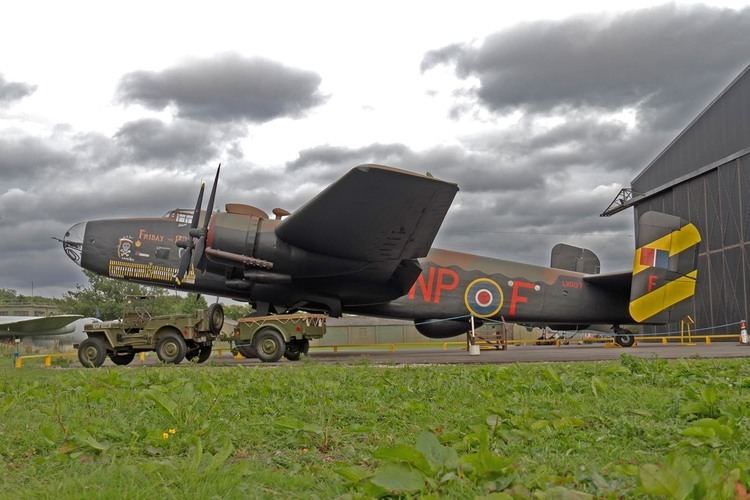
The redesign increased the span from 88 ft (27 m) to 99 ft (30 m) and put on 13,000 pounds (5,900 kg) of weight. Four Merlins were specified by the Ministry in September 1937. The mock-up was assessed at the end of the year and construction of the two prototypes of the HP57 began in March 1938.
Modifications resulted in the definitive HP57, which upon acceptance was given the service name Halifax, following the practice of naming heavy bombers after major towns – in this case, Halifax in the West Riding of Yorkshire. The H.P.57 was enlarged and powered by four 1,280 hp (950 kW) Rolls-Royce Merlin X engines. Such was the promise of the new model that the RAF had placed their first order for 100 Mk.I Halifaxes "off the drawing board" in January 1938 with serials already assigned to HP56 switched to HP57.
Having been built at Cricklewood then dismantled and taken by road to RAF Bicester the nearest non-operational RAF airfield with suitable facilities and a landing area larger than Radlett, after being secretly reassembled there, the maiden flight of the first prototype Halifax (serialled L7244) was made by chief test pilot Jim Cordes on 25 October 1939 with E A 'Ginger' Wright as flight test observer and the undercarriage locked down as an extra safety precaution. The first flight of the second prototype, L7245 (complete with full armament and equipment), was made by Cordes from Radlett on 17 August 1940.
Halifax production subsequently began at Handley Page's (now English Electric's) site in Samlesbury, Lancashire, with over 2,000 bombers being built by this factory during the war.
The Mk.I had a 22 ft (6.7 m) long bomb bay as well as six bomb cells in the wings, enabling it to carry 13,000 lb (5,900 kg) of bombs. Defensive armament consisted of two .303 in (7.7 mm) Browning machine guns in a Boulton Paul Type C nose turret, with an additional four in a Boulton Paul Type E tail turret, and, in some aircraft, two .303 in (7.7 mm) Vickers K machine guns in beam (side, or "waist") positions. The Merlins drove constant speed wooden-bladed Rotol propellers. Subtle modifications distinguished the Mk I aircraft. Aircraft of the first batch of fifty Mk I Halifaxes were designated Mk I Series I.
These were followed by 25 of the Mk I Series II with increased gross weight (from 58,000 lb/26,310 kg to 60,000 lb/27,220 kg) but with maximum landing weight unchanged at 50,000 lb (23,000 kg). The Mk I Series III had increased fuel capacity (1,882 gal/8,556 L), and larger oil coolers to accept the Merlin XX. A two-gun BP Type C turret mounted dorsally replaced the beam guns.
Introduction of 1,390 hp (1,040 kW) Merlin XX engines and a twin .303 in (7.7 mm) dorsal turret instead of waist guns resulted in the B Mk II Series I Halifax. The Mk II Series I (Special) achieved improved performance by removing the nose and dorsal turrets. The Mk II Series IA had a moulded Perspex nose (the standard for future Halifax variants), a four-gun Defiant-type dorsal turret, Merlin 22 engines and larger, trapezoidal-shaped vertical tail surfaces which solved control deficiencies from fin-stall with the roughly triangular-shape original surfaces, leading to rudder overbalance in the early marks. Halifax IIs were built by English Electric and Handley Page; 200 and 100 aircraft respectively.
Owing to a shortage of Messier-built landing gear and hydraulics, Dowty landing gear was used. As it was incompatible with the Messier equipment this gave Halifaxes with new designations: a Mark II built with Dowty gear was the Mark V. The use of castings rather than forgings in the Dowty undercarriage speeded production but resulted in a reduced landing weight of 40,000 lb (18,000 kg). The Mark V were built by Rootes Group at Speke and Fairey at Stockport and were generally used by Coastal Command and for training. Some 904 had been built when Mark V production ended at the start of 1944, compared to 1,966 Mk II.
The most numerous Halifax variant was the B Mk III of which 2,091 were built. First appearing in 1943, the Mk III featured the Perspex nose and modified tail of the Mk II Series IA but replaced the Merlin with the more powerful 1,650 hp (1,230 kW) Bristol Hercules XVI radial engine. Other changes included de Havilland Hydromatic propellers and rounded wing tips. The Mk IV was a non-production design using a turbocharged Hercules powerplant.
The definitive version of the Halifax was the B Mk VI, powered by the 1,800 hp (1,300 kW) Hercules 100. The final bomber version, the Mk VII, reverted to the less powerful Hercules XVI. However, these variants were produced in relatively small quantities.
The remaining variants were the C Mk VIII unarmed transport (8,000 lb/3,630 kg cargo pannier instead of a bomb bay, space for 11 passengers) and the Mk A IX paratroop transport (space for 16 paratroopers and gear). A transport/cargo version of the Halifax was also produced, known as the Handley Page Halton.
Accommodation and armament
The bomb aimer's position was in the extreme nose with the navigator's table behind it, both posts being fulfilled by the same crew member. Above the navigator was the forward gun turret. The wireless (radio) operator was behind the navigator's position, separated by a half width partition. The pilot (left side) and co-pilot (right side) (the flight engineer filled in as a co-pilot, seated on a folding seat, during crucial manoeuvres such as take-off) occupied the cockpit, above the wireless operator. Aft of the pilots and on the same level as the navigator and wireless operator was the flight engineer's compartment. A further compartment aft of the flight engineer contained two bunks originally intended for resting crew members, but almost always used for treating and berthing injured crew. This area led to the two-gun dorsal turret. The tail gunner occupied a four-gun turret at the extreme aft end of the aircraft.
In the Mk II Series IA and from the Mk III onward, there was no longer a nose turret. The bomb aimer occupied a streamlined perspex nose, with a single hand-held machine gun. The two-gun dorsal turret was replaced by a four-gun Boulton Paul turret.
The maximum bomb load was 14,500 lb (6,600 kg), carried in a bomb bay in the fuselage with six separate bomb compartments, and three bomb compartments in each wing inboard section. This division of bomb bays and compartments limited the maximum size of bomb which could be carried to 2,000 lb (910 kg).
Production
Halifaxes were assembled from sub-assemblies. The surface panels were flush riveted, although the application of the matte black night bomber camouflage, probably negated the benefit. Total Halifax production was 6,178 with the last aircraft delivered in April 1945. In addition to Handley Page, Halifaxes were built by English Electric, Fairey Aviation, and Rootes Motors (Rootes Securities Ltd) in Lancashire and by the London Aircraft Production Group. At peak one Halifax was completed every hour.
Operational service
The Halifax entered service with No. 35 Squadron RAF at RAF Linton-on-Ouse in November 1940; its first operational raid was against Le Havre on the night of 10–11 March 1941.
Air Chief Marshal Arthur Harris, head of Bomber Command, was scathing in his criticism of the Halifax's performance compared to the new Avro Lancaster, primarily of its bomb-carrying capability: it was calculated that an average Halifax would drop 100 tons of bombs in its lifetime compared to a Lancaster's 154. The fact that later Hercules-engined Halifaxes had lower loss rates and higher crew survival rates after abandoning the aircraft than Lancasters, and came very close to its speed and altitude performance, did not alter his opinion. Also, unlike the Lancaster, the Halifax's bomb bay could not be adapted to carry the 4,000 pound "Cookie" blast bomb which was an integral part of Harris's fire-bombing tactics. It was progressively outnumbered in frontline service over occupied Europe as more Lancasters became available from 1943 onwards, with many squadrons converting to the Lancaster. Halifaxes continued to be built because it was considered more efficient to allow existing manufacturing facilities to continue producing them efficiently, rather than stop production for an unknown period while they converted to the Lancaster, while new manufacturing facilities were devoted to the Lancaster. Halifax bombers were progressively relegated to secondary theatres such as North Africa and Italy, while many were converted to or built new as glider tugs, transports and maritime reconnaissance.
Harris's view of the Halifax changed sometime after spring 1942. In a reply on 2 June 1942, to a telegram sent by Frederick Handley Page congratulating him on the success of the first 1000 bomber Cologne raid, he stated: "My Dear Handley Page. We much appreciate your telegram of congratulation on Saturday night's work, the success of which was very largely due to your support in giving us such a powerful weapon to wield. Between us we will make a job of it."
In service with RAF Bomber Command, Halifaxes flew 82,773 operations and dropped 224,207 tons of bombs. 1,833 aircraft were lost. In addition to bombing missions, the Halifax served as a glider tug, electronic warfare aircraft for No. 100 Group RAF and special operations such as parachuting agents and arms into occupied Europe for the Special Operations Executive (SOE). Halifaxes were also operated by RAF Coastal Command for anti submarine warfare, reconnaissance and meteorological operations.
After the war Halifaxes remained in service with Coastal Command and RAF Transport Command, Royal Egyptian Air Force and the Armée de l'Air until early 1952. The Pakistan Air Force inherited Halifaxes from the RAF and continued to use them until 1961.
Civilian operation
A number of former RAF Halifax C.8s were sold from 1945 and used as freighters by a number of mainly British airlines. In 1948, the air freight market was in decline but 41 civil aircraft were used in the Berlin Air Lift operating a total of 4,653 sorties carrying freight and 3,509 carrying bulk diesel fuel. Nine aircraft were lost during the airlift. As the aircraft returned to England most civil Halifaxes were scrapped; the last civilian-operated Halifaxes were withdrawn from service in late 1952. The Low-cost airline business pioneer Freddie Laker bought and serviced war surplus Halifaxes for Bond Air Services operations in the Berlin airlift.
Pre-Halifax designs
H.P.57
Media related to Handley Page Halifax B Mark I at Wikimedia Commons
H.P.58
H.P.59
Media related to Handley Page Halifax B Mark II at Wikimedia Commons
Media related to Handley Page Halifax GR Mark II at Wikimedia Commons
Coastal Command variant of the Halifax B.II.H.P.61
Media related to Handley Page Halifax B Mark III at Wikimedia Commons
H.P.63
Media related to Handley Page Halifax B Mark V at Wikimedia Commons
H.P.70
Media related to Handley Page Halifax C VIII at Wikimedia Commons
H.P.71
H.P.70 Halton
Media related to Handley Page Halton at Wikimedia Commons
Halifax military operators
Halifax civil operators
Halton operators
Survivors
The Yorkshire Air Museum, on the site of the Second World War airfield, RAF Elvington, has a fully restored aircraft re-constructed from a fuselage section of Halifax B.Mk.II HR792 and parts from other aircraft including the wings from an RAF Hastings. It is painted to represent Halifax LV907, "Friday the 13th" from No. 158 Squadron RAF on the port side and "N - Novembre" of 347 "Guyenne" Squadron, Free French Air Force, on the starboard side (RAF Elvington being the home of the only two French heavy bomber squadrons in Bomber Command).
Another fully restored Halifax, NA337 of No. 644 Squadron RAF, then based at RAF Tarrant Rushton, is a transport/special duties version, and was retrieved from the bottom of Lake Mjøsa in Norway in 1995 after being shot down in April 1945. It was taken to Canada and restoration was completed in 2005. NA337 is a Halifax A.Mk.VII Special Duties aircraft built by Rootes Motors, at Liverpool Airport and is now preserved at the National Air Force Museum of Canada at CFB Trenton in Trenton, Ontario, near Kingston, Ontario.
A third Halifax is a B.Mk.II, serial W1048, 'S' for Sugar of No. 35 Squadron RAF. On the night of the 27/28 April 1942, this aircraft was taking part in a raid on the German battleship Tirpitz - its first operational flight. It was hit by anti-aircraft fire after releasing the four 1,000-pound (450 kg) mines it carried and the pilot made a successful belly landing on the frozen surface of Lake Hoklingen. The crew escaped to Sweden with the help of the Norwegian resistance, except for the Flight Engineer who remained behind because of a broken ankle and was taken prisoner. Within hours, the aircraft sank through the ice into 27 metres (89 ft) of water.
In the summer of 1973, it was recovered from the lake by a team of divers from the RAF and a Norwegian diving club, and was transported to the UK on a British Army Landing craft tank. It is displayed in its "as recovered" condition in the Bomber Command display at the Royal Air Force Museum at Hendon in London, apart from the nose turret which had already been restored prior to the decision.
The front fuselage section of Halifax MkVII PN323, built by Fairey Aviation at Manchester, is displayed at the Imperial War Museum in London. PN323 was the final Halifax scrapped, at Radlett, with the forward fuselage being recovered in 1965 and the nose section/crew compartment moved to the IWM 1978.
On 26 November 2006, archaeologists from the Warsaw Uprising Museum, Poland, unearthed remains of another Halifax (JP276 "A") from No. 148 Squadron RAF, which was found in southern Poland, near the city of Dąbrowa Tarnowska. It was shot down on the night 4–5 August 1944 while returning from the "air-drop-action" during the Warsaw Uprising.
In August 1945, while on weather patrol, the ageing Halifax bomber LW170 from No. 518 Squadron RAF sprang a fuel leak and, while trying to return to base, was forced to ditch off the Hebrides Islands west of Scotland. A project is currently underway with the stated aim of finding, recovering and restoring Halifax LW170. When it is recovered it will be restored and displayed at the Bomber Command Museum of Canada in Nanton, Alberta, Canada.
One side of the nose and cockpit of Halifax Mk. VII NP707, which completed 67 operations with No. 432 Squadron RCAF, was saved when the aircraft was scrapped after the war. It is now owned by the Bomber Command Museum of Canada.
In December 2014, a largely intact bomber wreck was discovered in a Norwegian fjord. It is believed to be Halifax W7656, which went missing on 28 April 1942, after an attack on the German battleship Tirpitz. As two of the crew failed to escape, the aircraft was designated a war grave.
Specifications (Mk III)
Data from Bingham, Halifax, Second to None
General characteristics
Performance
Armament
